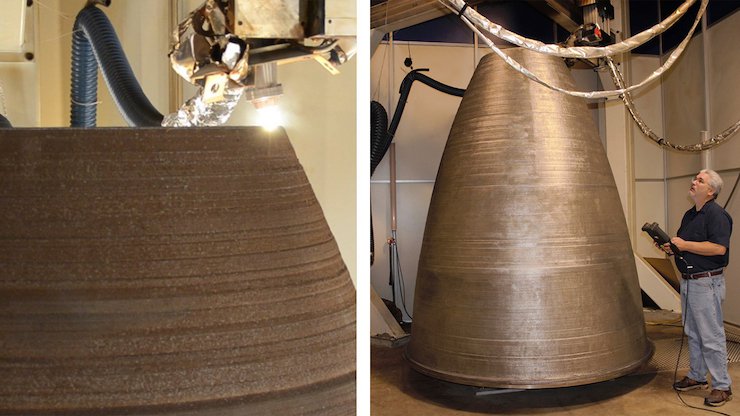DM3D Technology manufactures ten-foot-tall rocket nozzle liner for NASA project with DED 3D printing
DM3D Technology manufactures ten-foot-tall rocket nozzle liner for NASA project with DED 3D printing
BY SAM DAVIES, 24 AUGUST 2021
A Directed Energy Deposition (DED) 3D printing platform from DM3D Technology is being used by Auburn University in a liquid rocket engine project with NASA.

Two-tonne additively manufactured full-scale RS25 nozzle liner printed by DM3D Technologies.
The university’s National Center for Additive Manufacturing Excellence (NCAME) is working with NASA through the Rapid Analysis and Manufacturing Propulsion Technology (RAMPT) project, which aims to evolve large-scale and novel additive manufacturing techniques to improve liquid rocket engine performance.
DM3D’s closed-loop, multi-nozzle DED 3D printing technology has been developed to enable the additive manufacture of large and complex parts in the aerospace, defence and industrial sectors. Backed by significant IP assets that includes 40 awarded patents, DM3D’s DED technology relies on high power lasers to melt and deposit metal powder pixel by pixel, as well as a closed-loop feedback control that enables near-net shape part production.
Through the RAMPT project, it has been leveraged to manufacture a ten-foot-tall rocket nozzle liner demonstrator. Built over the course of several months – which is said to be a 50% reduction in processing time compared to traditional manufacturing methods – the exact dimensions of the two-tonne RS25 nozzle liner are 111 inches in height and 96 inches in diameter. Having worked with the University of Auburn and NASA for several years now, the RS25 nozzle liner represents a significant milestone for the partners as they look to continue ‘pushing the envelope’ on what DM3D’s DED technology can do.
“Knowing that the technology we’re developing for the RAMPT project could support future exploration missions is extremely gratifying,” commented DM3D President Bhaskar Dutta. “Auburn and NASA are very much at the forefront of AM research, and we began working with them around four years ago to print a nozzle that was approximately two feet in size, which seemed large at the time. Now, we’re printing one for the RAMPT programme that’s five times that height. This is one of the largest rocket engine components ever 3D printed.”
The work being carried out via the RAMPT project has been funded through the NASA Game Changing Development Program with the agency’s Space Technology Mission Directorate. As the partners continue developing the DED technology and testing its application capabilities, they will be hoping it is money well spent.
“NASA has established these public-private partnerships to advance new approaches, process build volumes, materials and component demonstrations using additive manufacturing,” commented Paul Gradl, RAMPT co-principal investigator and a Senior Propulsion Engineer at NASA’s Marshall Space Flight Center. “The goal is to increase the technology readiness level to allow infusion into future NASA missions and commercial space applications.”
“DM3D’s cutting-edge technology and NCAME’s expertise in materials characterisation ad qualification will continue the advancement and infusion of these technologies in future missions and allow for industry to continue to build upon this development for other new, large-scale applications,” added Auburn University’s NCAME Director and RAMPT Technical Lead Nima Shamsaei.